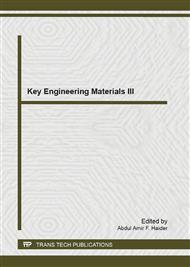[1]
S. Rassmann, R. Paskaramoorthy and R.G. Reid: Materials and Design Vol. 32 (2011), p.1399–1406.
Google Scholar
[2]
D.M.A. Farias, M.Z. Farina, A.P.T. Pezzin and D.A.K. Silva: Materials Science and Engineering Vol. 29 (2008), p.510–513.
Google Scholar
[3]
W.D. Bascom and D.L. Hunston: Rubber-Toughened Plastics, (1989), pp.135-172.
Google Scholar
[4]
Y.P. Lee, H.S. Ahmad, R. Rasid, Y.E.N. Se, H.K. Yew and M.A. Tarawneh: Sains Malaysiana Vol. 40 (2010), p.679–683.
Google Scholar
[5]
H. Ismail and A. Suryadiansyah: Journal of Reinforced Plastics & Composites Vol. 23(6) (2004), p.639–650.
Google Scholar
[6]
H.Y. Li, H.Z. Chen, W.J. Xu, F. Yuan, J.R. Wang and M. Mang Wang: Physicochem. Eng. Aspects Vol. 254 (2005), p.173–178.
Google Scholar
[7]
J.S. Tan, and N.A.F.N. Farid: Separation and Purification Technology Vol. 35 (2004), p.47–54.
Google Scholar
[8]
J.M. Degrange, M. Thominea, Ph. Kapsa, J.M. Pelletier, L. Chazeau, G. Vigier, G. Dudragne and L. Guerbe: Wear Vol. 259 (2005), p.684–692.
DOI: 10.1016/j.wear.2005.02.110
Google Scholar
[9]
A. Khalil, N.Z. Noriman, M.N. Ahmad, M.M. Ratnam and N.A.N. Fuaad: Journal of Reinforced Plastics and Composites Vol. 26(2007), pp.305-311.
Google Scholar
[10]
N.S.M. El-Tayeb: Wear Vol. 265 (2007), pp.223-235.
Google Scholar
[11]
M.L. Auad, P.M. Frontini, J. Borrajo and M.I. Aranguren: Polymer Vol. 42 (2000), pp.372-373.
Google Scholar
[12]
A.H.P.S. Khalil, P. Firoozian, I.O. Bakare, M.H. Akil and M.A. Noor: Materials and Design Vol. 31 (2010), pp.3419-3425.
DOI: 10.1016/j.matdes.2010.01.044
Google Scholar
[13]
N.N. Bonnia, S.H. Ahmad, I. Zainol, A.A. Mamun, M.D.H. Beg and A. K. Bledzki: eXPRESS Polymer Letters Vol. 4(2) (2010), p.55–61.
DOI: 10.3144/expresspolymlett.2010.10
Google Scholar
[14]
R.V. Silva, D. Spinelli, F.W.W. Bose, N.S. Claro, G.O. Chierice and J.R. Tarpani: Compos. Sci. Techno. Vol. 66(10) (2006), pp.1328-35.
Google Scholar
[15]
P. Firoozian, A.H.P.S. Khalil, M.H. Akil and M.A. Noor: Advanced Materials Research Vol.264-265 (2011), pp.513-517.
Google Scholar
[16]
R. Thomas, Y. Ding, Y. He, L. Yang, P. Moldenaers, W. Yang, T. Czigany and S. Thomas: Polymer Vol 49 (2008), pp.278-294.
Google Scholar
[17]
S.Y. Fu, X.Q. Feng, L. Bernd and Y.M. Mai: Composites Part B Vol. 39 (2008), p.933–961.
Google Scholar
[18]
C. Yu and C. Wei: Advanced Materials Research Vol. 194-196 (2011), pp.1772-1775.
Google Scholar
[19]
X. Wen, Y. Wang, J. Gong, J. Liu, N. Tian, Y. Wang, Z. Jiang, J. Qiu and T. Tang: Polymer Degradation and Stability Vol. 97 (2012), pp.793-801.
DOI: 10.1016/j.polymdegradstab.2012.01.031
Google Scholar
[20]
M. Li and D. Liu: Advanced Materials Research Vol. 418-420 (2012), pp.1452-1455.
Google Scholar


